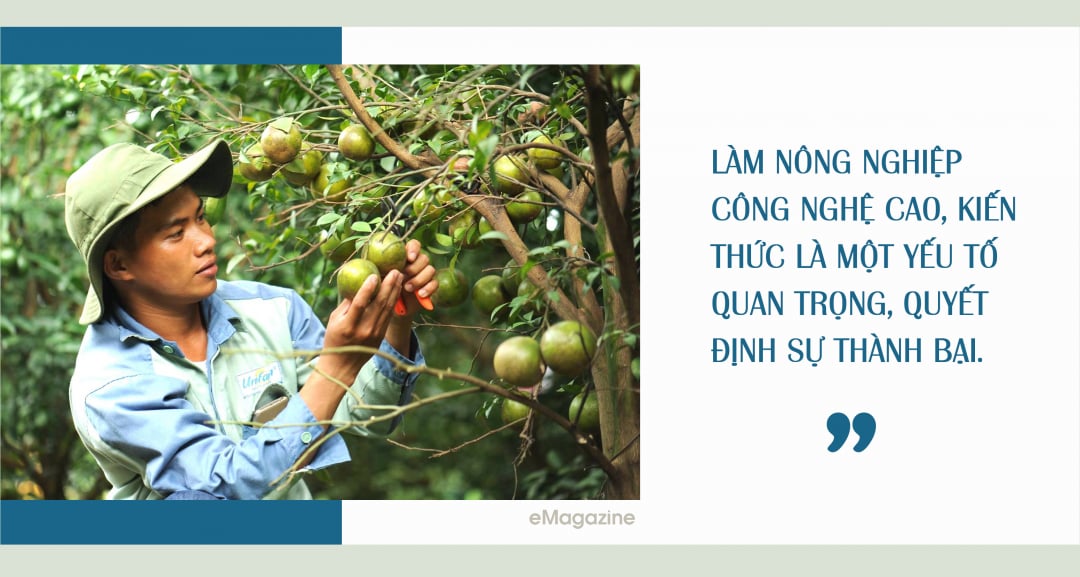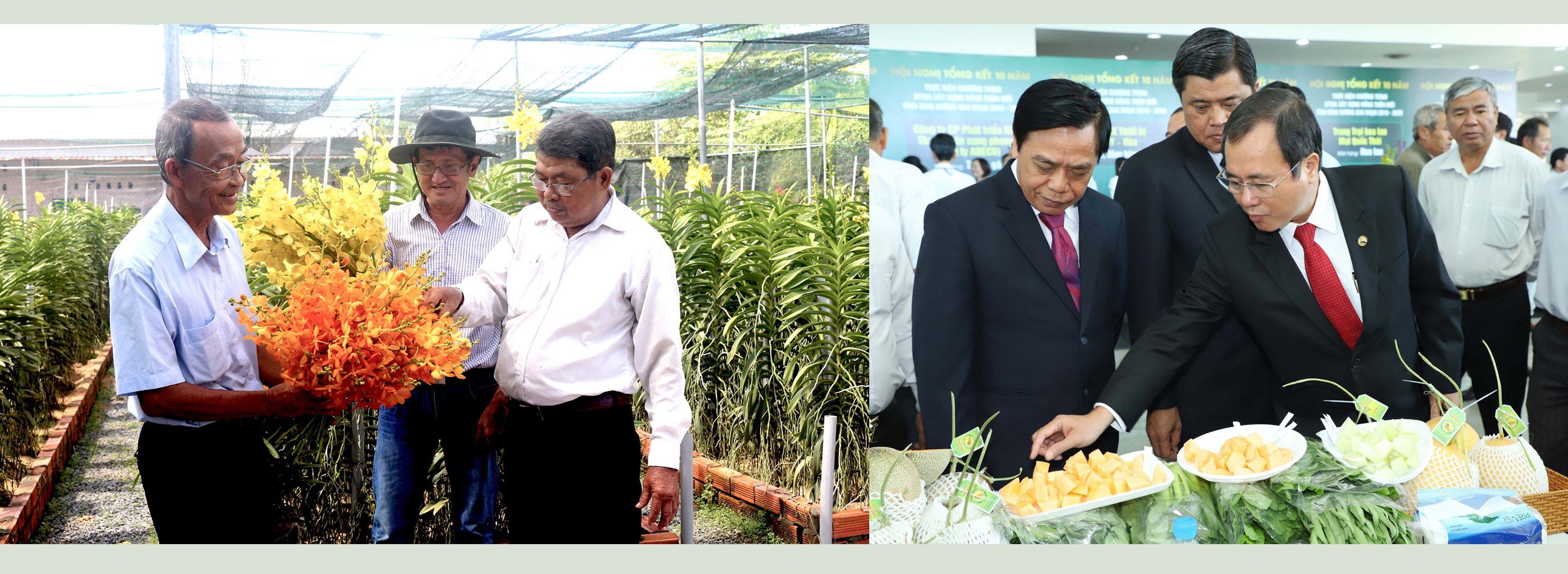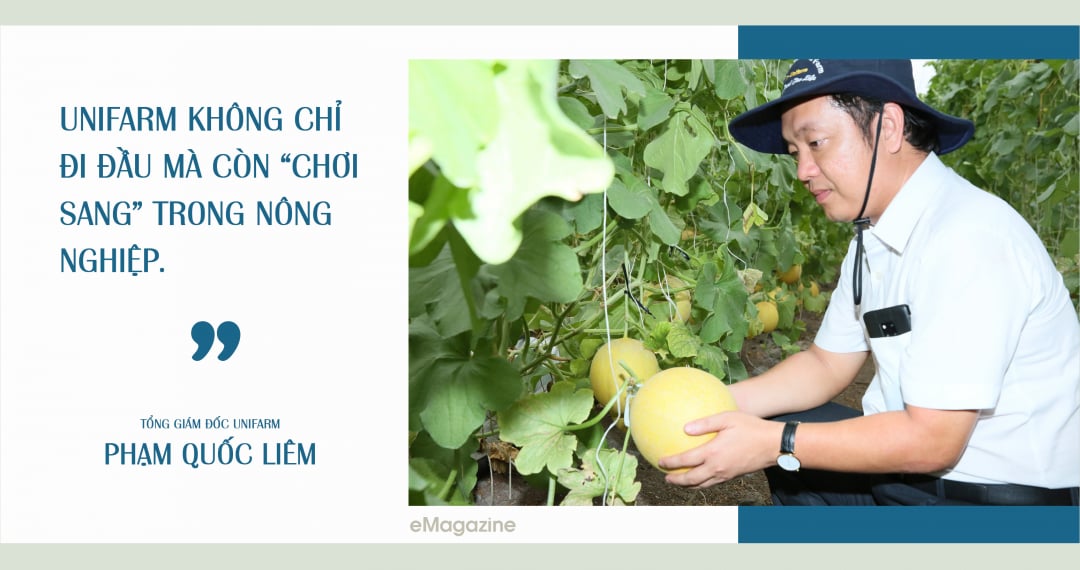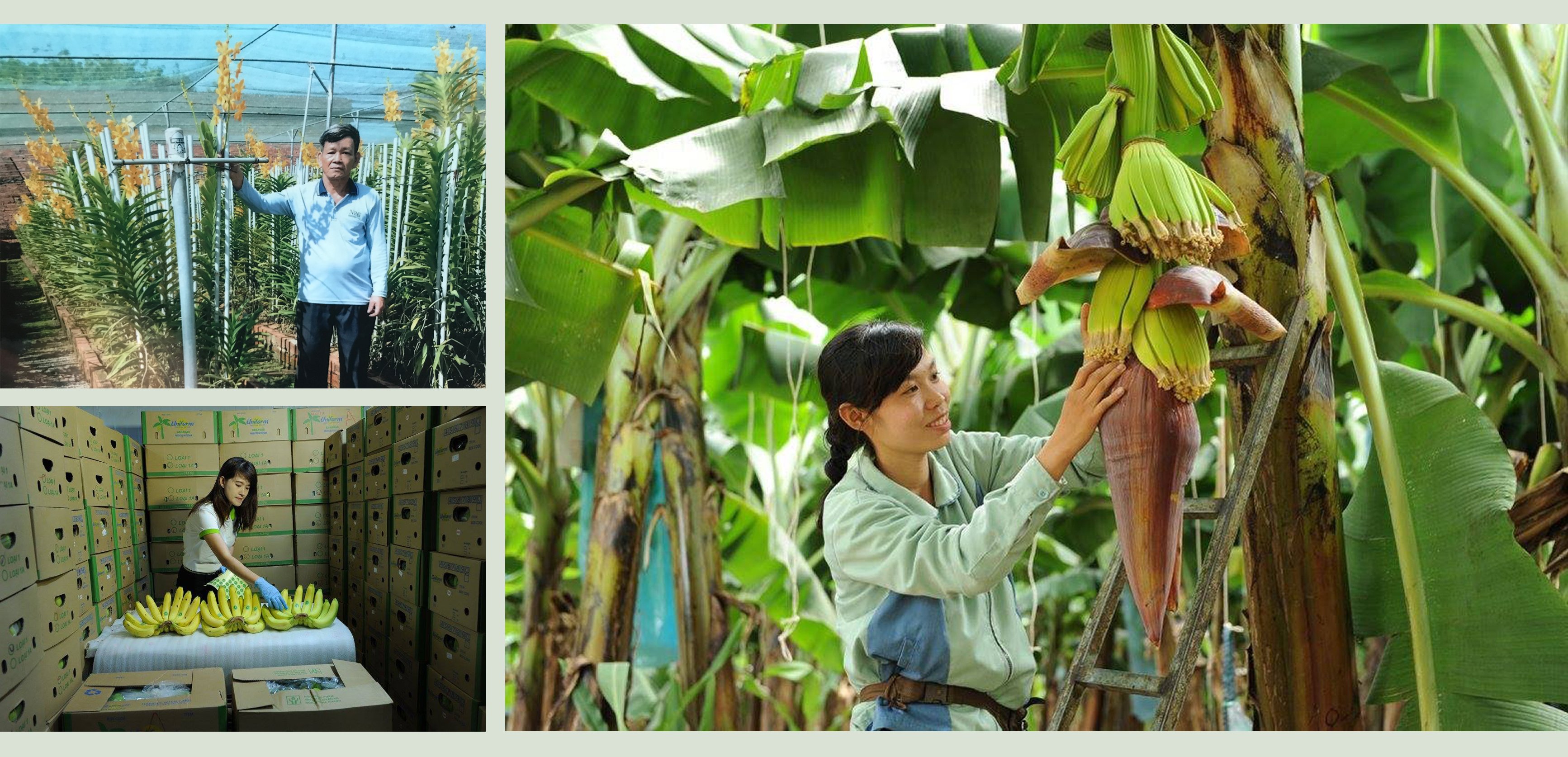May 24, 2025 | 10:14 GMT +7
May 24, 2025 | 10:14 GMT +7
Hotline: 0913.378.918
May 24, 2025 | 10:14 GMT +7
Hotline: 0913.378.918
Amid the realities of the sinking of farmland to give spaces for urbanization, the urgent need is how to produce more with less, Binh Duong province soon realized the problem and made a plan to invest in agriculture following urban farming direction. As a result, the province is not only early but also in the right direction.
A lot of agriculture models, from individuals to enterprises have been well-invested creating the very high added values.
One day in mid-May, we visited Le Van Dat's orchid garden in Dinh Hoa Ward, Thu Dau Mot City. The garden was producing cut Mokara orchid. This is one of the most efficient urban farming model thanks to catching up with the market trends along with effective supports from local authorities.
Dat said he has hobby in growing ornamental plants and has grown orchids for a long time. Few years ago, seeing his beautiful pots of Mokara orchid, many people asked to buy them. He sold out and grew again. Gradually, the entire 1,000 square meters of his family's land were invested to grow orchids. All labors working at the garden were his family members. Thus, he earned more than VND 10 million after counting all costs.
Dat's success story became an example for other locals to learn and they all achieved success. So far, these orchid growers have linked to each other to establish Dat Thu Orchid Cooperative. The cooperative has 87 members cultivating on an area of 8 hectares. The trademark "Dat Thu Orchid" has been certificated by the National Office of Intellectual Property under the Ministry of Science and Technology. Currently, the Cooperative has provided thousands of orchid cuts to the market priced at VND 5,000 - VND 6,000 per cut.
Especially, Dat's orchid garden was chosen to join the project " Mokara orchid growing model following new technologies" and worked as a performance model. Dat said his orchid garden was installed with a semi-automatic sprinkler irrigation system. Thanks to strict application of technical process from seeds selection to pest and disease control and prevention, his orchid garden grew very well. If in conventional orchid gardens, orchid grew only 1-2 leaves/month, orchids in Dat's garden grew 2-4 leaves/month and the leaves have beautiful glossy green and are not only large in width but also longer. The numbers of flower braches growing from each orchid plant is also more than usual, from 2-6 branches depending on varieties.

Another successful agricultural model is the six-hectare Dendro orchid Garden of Mai Quoc Thai in Minh Hoa commune, Dau Tieng district . This is considered as the largest orchid garden in the Southeast region. The whole farm is specialized in growing Dendro orchid variety for selling cut and potted flowers. After counting all expenses the farm generates more than VND 4 billion profit per year, creating stable jobs for dozens of local workers.
According to Thai, pursuing hi-tech agriculture, knowledge is an important element determining success or failure. Thai used to be an engineer and a lecturer at Ho Chi Minh City University of Agriculture and Forestry. Then, he decided to quit his job to start farming. Before gaining success with orchid farming model, he failed many times when trying to grow rubber, mango and pomelo.
"One time when I watched a TV program about Thailand's Dendro orchid, I was curious and wanted to know more about it; then I decided to "conquer" this difficult flower species", Thai remembered.
After that, Thai went to Thailand to learn how to grow this type of orchid. Returning to his home country, he continued to learn experience of growing Dendro orchid from gardens in Tay Ninh, Long An, Ba Ria - Vung Tau, Dong Nai, Binh Phuoc .
Dendro orchid has beautiful flowers which are welcomed in the market. However when he asked how to grow this type of orchid, how to take care of them, many gardeners refused to unveil the answers."With the thought, the more difficult it is the more opportunity I have, so day and night I try to find out how to grow and how to care for this particular type of orchid."
Thanks to the strong support and assistance from his wife and daughter (both are engineers graduating from Ho Chi Minh City University of Agriculture and Forestry), finally Thai successfully "conquer" Dendro orchid.

It can be said that the success of urban farming model in Binh Duong has a significant contribution from local government. With the goal of building large-scale and hi-tech farms cultivating cut orchid flowers, the agricultural extension center of Binh Duong province also has regularly invited experts to provide technical support as well as develop effective production models for farmers, helping them with specialized fertilizers for orchid growing and importing new varieties to assist gardeners.
So far, almost 90% of commercial cut orchid flowers grown in Binh Duong is the first rank in the market. Up to now, the farms growing cut orchid flowers in the province are confident in farming and caring techniques.
Besides, to help farmers towards commercial orchid production , Binh Duong province issued a decision to assist farmers with preferential loans to turn to hi-tech agriculture. This is really meaningful for households that are conducting crop conversion and choosing the model of growing cut orchids as a new development direction.
But it doesn't stop there, the province's authorities have worked with orchid growers to actively promote the image of Dat Thu orchids in the domestic market. And, orchid growers are strongly applying sciences and technologies to improve the quality of orchid flowers towards high yield and high quality.
Apart from hundreds of hi-tech and urban farming models, Binh Duong also develops concentrated agricultural zones which are well-invested and modern. Currently, there are four hi-tech agricultural zones including Tien Hung hi-tech agricultural zone in Bac Tan Uyen district; hi-tech agricultural zone in the communes of Tan Hiep and Phuoc Sang, Phu Giao district; hi-tech agricultural zone in Vinh Tan commune, Tan Uyen town and An Thai hi-tech agricultural zone in Phu Giao district.
Among these agricultural zones, An Thai hi-tech agriculture zone in An Thai commune, Phu Giao district is leading in applying hi-tech agriculture model. So far, An Thai has become the most successful agricultural zone in Binh Duong with the products such as bananas, longans, cantaloupes meeting the standards of VietGAP, Global GAP . These products are not only well-known and dominate the domestic market but also put up for sale at overseas markets such as the US, Japan, South Korea and Taiwan.
To have a successful agricultural model as today, An Thai started for scratch. In 2008 when An Thai began the project, there wasn't any successful hi-tech agriculture model in the country, Unifarm had to learn to do for itself.
Unifarm's General Director Pham Quoc Liem said, at the time of establishment, Unifarm had only 10 members who were leaders and technicians. They had to split up to go overseas to learn from the top agricultural producing countries and regions such as Israel, Taiwan, Japan to learn about hi-tech agriculture. Beyond that, Unifarm also hired experts from Israel, Philippines for technical consulting.

In 2010, Unifarm was willing to spend nearly ten billion Vietnam dong to invest in one-hectare greenhouse. This was a closed system including irrigation, fertilization, temperature and humidity controls and automatically controlled by computer.
"Between 2009 and 2010, there was no enterprises daring to invest such a huge amount of money. So, many people joked that Unifarm was not only taking the leading role but also willing to invest in agriculture," Unifarm's General director Pham Quoc Liem said.
The main crop Unifarm putting into cultivation in its greenhouse system was cantaloupe, a fruit that was newly introduced in Vietnam and quite "hot" in the market. Thanks to methodical investment, strict application of advanced technical processes under the supervision of foreign experts, Unifarm enjoyed bumper harvest of cantaloupe in the first crop. Although Unifarm's cantaloupes were cheap at half the price of the imported fruits, they became popular with consumers thanks to the high quality.
From one hectare of cantaloupe, the company increased to three hectares and continuously expanding the cultivation area when it realized that the demand for this type of fruit in Binh Duong and neighboring provinces and cities has increase steadily.
In addition to cantaloupes, Unifarm also spent a lot of time on researches and growing trials of more than 20 fruits and vegetables. Finally, they selected some of crops suitable to develop and banana is one of them.
In 2013, 10 hectares of banana were harvested with an average yield of 50 tons per hectare. Unifarm's bananas met criteria for exports to South Korea, Japan and the US. That was the first success of Unifarm.

Beside key product - bananas, cantaloupes are now put up for sale at most of the large supermarkets across the country with the ratio of export to import 50/50. Unifarm also produces other fruits such as sugar tangerine, Ido longan originating from Thailand with outstanding characteristics including thin skin, tiny seed, thick flesh , sweet, aromatic and crispy taste. These fruits are very popular with consumers.
At present, Unifarm has over 12 hectares of greenhouse cantaloupe; it harvests three crops per year with a yield of 100 tons per hectare per year.
At the same time, Unifarm has transferred and replicated cantaloupe farming techniques to other farms inside and outside the province. Every year, a lot of people from every corner of the country visit the farm to learn experience.
"It shows that more and more individuals and groups aspire to become rich and successful . We hope that more and more farmers will understand farming techniques and cultivation processes and apply innovations in production. Unifarm is willing to transfer technologies and help farmers convert crops and consume the products", said Pham Minh Tiep, Unifarm's Deputy Technical Manager.

From the beginning , Unifarm has its own choice that is focusing on the quality and safety of the products, thereby Unifarm's farm produce met the standards to access the demanding markets such as Japan, South Korea, Singapore. Compared to other agricultural enterprises tending to export to the Chinese market, the quality of Unifarm's products is completely different. Therefore, Unifarm has never need to have the products "rescued".
With the aim of becoming one of the world's top producers of high-quality bananas, in 2014 Unifarm decided to cooperate with Dole Asia Holding, the world's largest producer and marketer of high quality fresh fruits. After that, Dole sent technicians from Philippines and other top banana producing countries to Vietnam to assist Unifarm to supervise the quality. Many Unifarm's technicians were sent to Philippines for training.
In 2016, Unifarm and Dole decided to raise their cooperation to a new height by signing a contract to cultivate more 1,200 hectares of banana more to become Dole 's exclusively exporter to Japan and Malaysia. Particularly, Unifarm is trusted by Dole to trade bananas it grows under the monitoring and supervision of Dole's experts. These bananas are labeled Dole trademark in the Vietnamese market in addition to other banana lines registered as Unifarm trademark.
According a report of Binh Duong province, from 2016 until now, the province's production areas with hi-tech application has tripled with more than 5,345 hectares.
So far, the whole province has 75 farming facilities receiving VietGAP certificate with a total area of around 469 hectares. Average value of output per 1 hectare of agricultural production land is VND 95 million per year and could be up to VND 1 billion per year for the hi-tech pomelo farming models.
Hi-tech livestock production is stable with 142 farms which are invested to raise breeding chickens, broiler chickens and laying hens with 8.3 million heads in total. Besides, there are 154 farms raising a total of 517,000 pigs for meat and for high quality breeding together 15 farms raise 205 broiler ducks.
Restructuring agricultural sector in line with the industrialization and urbanization rates is taking place strongly. Recently, the Provincial Party Committee and the People's Committee of Binh Duong province has set programs and plans to create a lever to help farmers expand the effective urban farming models.
To develop an urban farming model substantially, the provincial People's Committee of Binh Duong province approved the project on Urban Agriculture Development in the Southern Binh Duong for the period 2016-2020 in order to develop urban agriculture with various forms and creating sustainable value chains on the basis of high technology application.
Accordingly, individuals, cooperatives having plans for investing in urban farming will be supported with preferential loans from the provincial budget with interest rates equivalent to 70% minimum interest rate of Binh Duong Development Investment Fund at a certain time which is decided by the Provincial People's Committee. Preferential loans extend up to five years. Loan limit is from 70-80% value of the lending demand depending on the size of project.
As a result, the Department of Agriculture and Rural Development of Binh Duong province has received and approved 107 projects applying for the preferential loans with a total capital of nearly VND1 trillion . Currently, 76 projects with suggested loans of VND 650 billion of which VND 572 billion were approved. Up to now, Binh Duong Development Investment Fund has disbursed VND 526 billion as scheduled without any outstanding debt.
Efficiency of loans has contributed to the restructuring of crops and livestock in the province,
Many scientific and technical innovations have been applied. The models of urban farming and hi-tech agriculture have been increasingly developed in both quality and quantity which benefits farmers in the province.
According the Provincial People's Committee of Binh Duong, the project aims to speed up the agricultural restructuring process towards diversifying production models, linking production with the market, processing and urbanization.

Obviously, the programs and policies issued by Binh Duong province is really a lever to help urban farming in Binh Duong to take off in terms of numbers and size . Many scientific and technical advances has been applied widely.
In recent years, Binh Duong province has seen rapid urbanization and industrialization. It is inevitable. Apart from achievements, this process also quickly narrows the resources for agriculture . Local workers, especial the elders and women are more and more underemployed and facing many challenges in the short and long term.
Director of the Department of Agriculture and Rural Development of Binh Duong province, Pham Van Bong said:"In order to balance the landscape and overcome the negative impacts of industrialization and urbanization, pushing up urban farming is an important solution to brign high and sustainable efficiency. In addition, the development of urban farming also plays an important role in reforming the landscape, providing safe, clean and on-site food to city dwellers ensuring health of people....

(VAN) The People's Committee of Tra Vinh province has approved an adjustment to the investment policy for the Green Hydrogen Plant project, increasing its area to approximately 52.76 hectares.
![Reducing emissions from rice fields: [2] Farmers’ commitment to the soil](https://t.ex-cdn.com/nongnghiepmoitruong.vn/608w/files/news/2025/05/05/dsc08881jpg-nongnghiep-140632.jpg)
(VAN) Clean rice cultivation model in Thuong Tan commune, Bac Tan Uyen district, is assisting local residents in achieving sustainable agriculture by substantially reducing costs, increasing productivity, and protecting the environment.

(VAN) At the conference to disseminate Resolution No. 68, AgriS introduced its digital agricultural ecosystem and reaffirmed its commitment to accompanying the Government in promoting private sector development and sustainable agriculture.

(VAN) 'Blue Ocean - Blue Foods' initiative is designed to restore marine ecosystems and establish sustainable livelihoods for local communities by cultivating a minimum of 1,000 hectares of cottonii seaweed in the first three years.
/2025/05/21/4642-3-112707_603.jpg)
(VAN) The V-SCOPE project has made direct contributions to three out of six pillars of the Comprehensive Strategic Partnership between Vietnam and Australia.

(VAN) Facing the threat of rabies spreading to the community, Gia Lai province urgently carries out measures to vaccinate dogs and cats on a large scale.

(VAN) Disease-free livestock farming not only protects livestock herds but also stabilizes production and livelihoods for many farmers in Tuyen Quang.